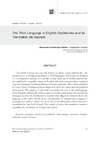Identificador persistente para citar o vincular este elemento:
https://accedacris.ulpgc.es/jspui/handle/10553/15513
| Campo DC | Valor | idioma |
|---|---|---|
| dc.contributor.author | Santamaría Urbieta, Alexandra | es |
| dc.date.accessioned | 2016-01-27T03:30:16Z | - |
| dc.date.accessioned | 2018-03-15T14:36:05Z | - |
| dc.date.available | 2016-01-27T03:30:16Z | - |
| dc.date.available | 2018-03-15T14:36:05Z | - |
| dc.date.issued | 2014 | es |
| dc.identifier.issn | 1133-1127 | es |
| dc.identifier.uri | https://accedacris.ulpgc.es/handle/10553/15513 | - |
| dc.description.abstract | This article focuses on a specific feature found in tourist guidebooks –the recurrent use of foreign expressions or “third language”. It presents the findings of a comparative analysis of a parallel corpus made up of twenty guidebooks: ten guidebooks originally written in English and their corresponding translated versions in Spanish, describing different countries and cities (all of them published by Lonely Planet), focusing on those chapters in which the writer includes practical information. The purpose of the study is to analyze the use of the third language in the English and Spanish versions and to determine and identify the translation strategies used by the translators to transfer these linguistic elements from one language to the other. | es |
| dc.description.abstract | El objetivo del presente artículo es realizar un estudio sobre el uso habitual de expresiones extranjeras o “tercera lengua” en guías de viaje, más concretamente, en aquellos apartados en los que el escritor incluye información práctica para el viajero. Lo qque aquí se presenta son los resultados de un análisis comparativo de un corpus paralelo formado por veinte guías de viaje: diez guías escritas originalmente en inglés y sus correspondientes versiones traducidas al español. Todas ellas publicadas por la editorial Lonely Planet y que describen diferentes ciudades y países. El objetivo de este estudio es analizar el uso de la tercera lengua en las versiones en inglés y en español, así como determinar e identificar las estrategias de traducción utilizadas por los traductores para transferir estos elementos lingüísticos de una lengua a otra. | - |
| dc.format | application/pdf | es |
| dc.language | eng | es |
| dc.relation.ispartof | LFE. Revista de Lenguas para Fines Específicos | es |
| dc.source | LFE. Revista de lenguas para fines específicos. Las Palmas de Gran Canaria: Universidad de Las Palmas de Gran Canaria, 1993-. ISSN 1133-1127.e-ISSN 2340-8561 n. 20, 2014 | es |
| dc.subject | 570107 Lengua y literatura | es |
| dc.subject | 550510 Filología | es |
| dc.title | The third language in English guidebooks and its translation into Spanish | es |
| dc.type | info:eu-repo/semantics/article | es |
| dc.type | Article | es |
| dc.identifier.doi | 10.1400/229695 | - |
| dc.compliance.driver | 1 | es |
| dc.identifier.absysnet | 233536 | es |
| dc.identifier.crisid | - | - |
| dc.investigacion | Artes y Humanidades | es |
| dc.rights.accessrights | info:eu-repo/semantics/openAccess | es |
| dc.type2 | Artículo | es |
| dc.identifier.ulpgc | Sí | es |
| dc.description.esci | ESCI | |
| dc.description.dialnetimpact | 0,0 | |
| dc.description.dialnetq | Q3 | |
| dc.description.erihplus | ERIH PLUS | |
| item.grantfulltext | open | - |
| item.fulltext | Con texto completo | - |
| Colección: | LFE, Rev. leng. fines específ. n.20, 2014 Artículos | |
Citas de WEB OF SCIENCETM
Citations
1
actualizado el 08-jun-2025
Visitas
93
actualizado el 21-dic-2024
Descargas
149
actualizado el 21-dic-2024
Google ScholarTM
Verifica
Altmetric
Comparte
Exporta metadatos
Los elementos en ULPGC accedaCRIS están protegidos por derechos de autor con todos los derechos reservados, a menos que se indique lo contrario.
